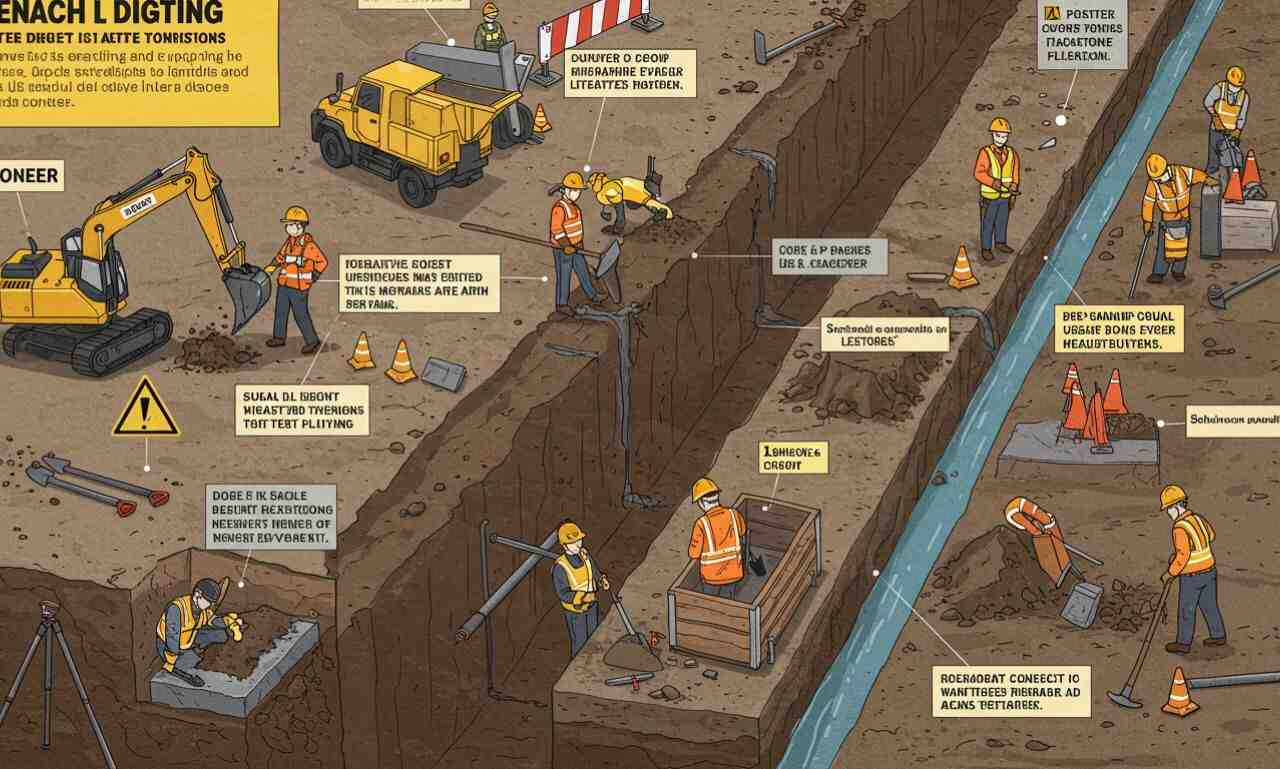Digging trenches may seem like a straightforward task, but it involves much more than just moving soil. Whether you’re working on a landscaping project, installing pipes, laying cables, or constructing a foundation, understanding how to dig trenches properly is essential. From choosing the right tools to following safety practices, trench digging requires preparation, planning, and technique.
In this guide we’ll explore everything you need to know about digging trenches, including methods, equipment, common challenges, and expert tips to ensure efficiency and safety.
What is Trench Digging?
A trench is a narrow excavation in the ground that is deeper than it is wide. Trench digging is a process used for:
-
Installing utilities like water lines, gas pipes, and electrical cables.
-
Drainage systems such as French drains or stormwater channels.
-
Landscaping for garden edging, irrigation, or tree planting.
-
Construction foundations for walls, fences, or other structural projects.
While trenches can range in size from shallow garden channels to deep utility excavations, the principles of safe and efficient digging remain the same.
Tools and Equipment for Digging Trenches
Choosing the right tools can make trench digging faster, easier, and safer. Here are the most commonly used options:
1. Manual Tools
-
Shovels & Spades: Best for small trenches and light soil.
-
Mattock or Pickaxe: Useful for breaking compacted ground or rocky soil.
-
Trenching Shovel: Designed with a narrow blade for precision digging.
2. Power Tools & Machinery
-
Trencher Machine: Available in walk-behind and ride-on models, ideal for long, deep, or wide trenches.
-
Mini Excavator: Great for heavy-duty trenching and when working on construction sites.
-
Augers: Used for digging post holes but can also help with narrow trenches.
3. Supportive Tools
-
Measuring Tape & Stakes: To mark out the trench accurately.
-
String Line: Ensures straight lines for uniform trenches.
-
Wheelbarrow: For transporting soil efficiently.
Planning Before Digging
Before starting, proper planning is essential. Here are steps to follow:
1. Identify Purpose
Ask yourself why you need the trench. The depth and width will vary depending on whether it’s for irrigation pipes, foundation work, or drainage.
2. Check Utility Lines
Always contact local utility companies to mark underground lines before digging. Accidentally striking water or gas pipes can be dangerous and costly.
3. Mark the Area
Use spray paint, stakes, and string lines to outline the exact location and dimensions of the trench.
4. Check Soil Conditions
Soil type influences how easy or difficult trenching will be. Sandy soil is easier to dig but prone to collapsing, while clay soil is tougher but more stable.
Techniques for Efficient Trench Digging
1. Manual Digging
For small projects, manual trenching is cost-effective. Start by loosening the soil with a pickaxe or mattock, then use a trenching shovel to remove soil.
2. Using a Trencher Machine
Trenchers are highly efficient for large projects. Walk-behind trenchers are suitable for residential yards, while ride-on trenchers work best for commercial projects.
3. Excavator Digging
Mini excavators provide precision and depth for heavy-duty jobs, especially when dealing with compacted soil or rocky terrain.
Safety Tips for Trench Digging
Trench digging can be hazardous if safety precautions are ignored. Here are key guidelines:
-
Wear Protective Gear: Gloves, safety boots, and helmets are essential.
-
Prevent Collapse: For trenches deeper than 5 feet, use trench boxes or shoring systems.
-
Work in Pairs: Never dig deep trenches alone. Always have someone nearby.
-
Mind the Weather: Avoid digging in heavy rain since water can weaken trench walls.
-
Watch for Exhaustion: Take breaks when digging manually, as trenching is physically demanding.
Common Challenges and How to Overcome Them
-
Hard or Rocky Soil
-
Use a pickaxe, mattock, or power tools to break up the soil.
-
-
Trench Collapse
-
Shore up the walls or use trench boxes to prevent accidents.
-
-
Water Accumulation
-
Pump out water using a sump pump or dig drainage channels.
-
-
Uneven Trenches
-
Use measuring tools and string lines for accuracy.
-
Environmental Considerations
Trench digging can affect the environment. Be mindful of:
-
Tree Roots: Avoid cutting major roots, as it can harm or kill trees.
-
Soil Erosion: Replace topsoil after trenching to prevent erosion.
-
Local Regulations: Some areas require permits for large excavation projects.
Expert Tips for Better Trenching
-
Use the Right Tool for the Job: Don’t struggle with a shovel if a trencher can save hours.
-
Dig in Stages: For deep trenches, dig in layers instead of trying to reach full depth at once.
-
Dispose of Soil Properly: Store soil away from the trench edge to avoid collapses.
-
Plan for Backfilling: Once utilities are installed, compact soil properly to prevent settling.
Applications of Trenches in Modern Projects
Trench digging remains essential across multiple industries:
-
Construction: Foundations, retaining walls, and fence posts.
-
Utilities: Installing water, sewage, electrical, and gas lines.
-
Agriculture: Irrigation systems and drainage channels.
-
Landscaping: Garden edging, lighting installations, and decorative features.
Conclusion
Digging trenches may look like a simple task, but it requires planning, the right tools, and attention to safety. From small landscaping projects to large-scale construction, trench digging plays a vital role in modern infrastructure. By using proper techniques, following safety guidelines, and choosing the right equipment, you can make trenching efficient and effective.
Whether you’re a homeowner tackling a DIY garden project or a contractor working on a construction site, understanding the essentials of trench digging ensures success and safety every time.
